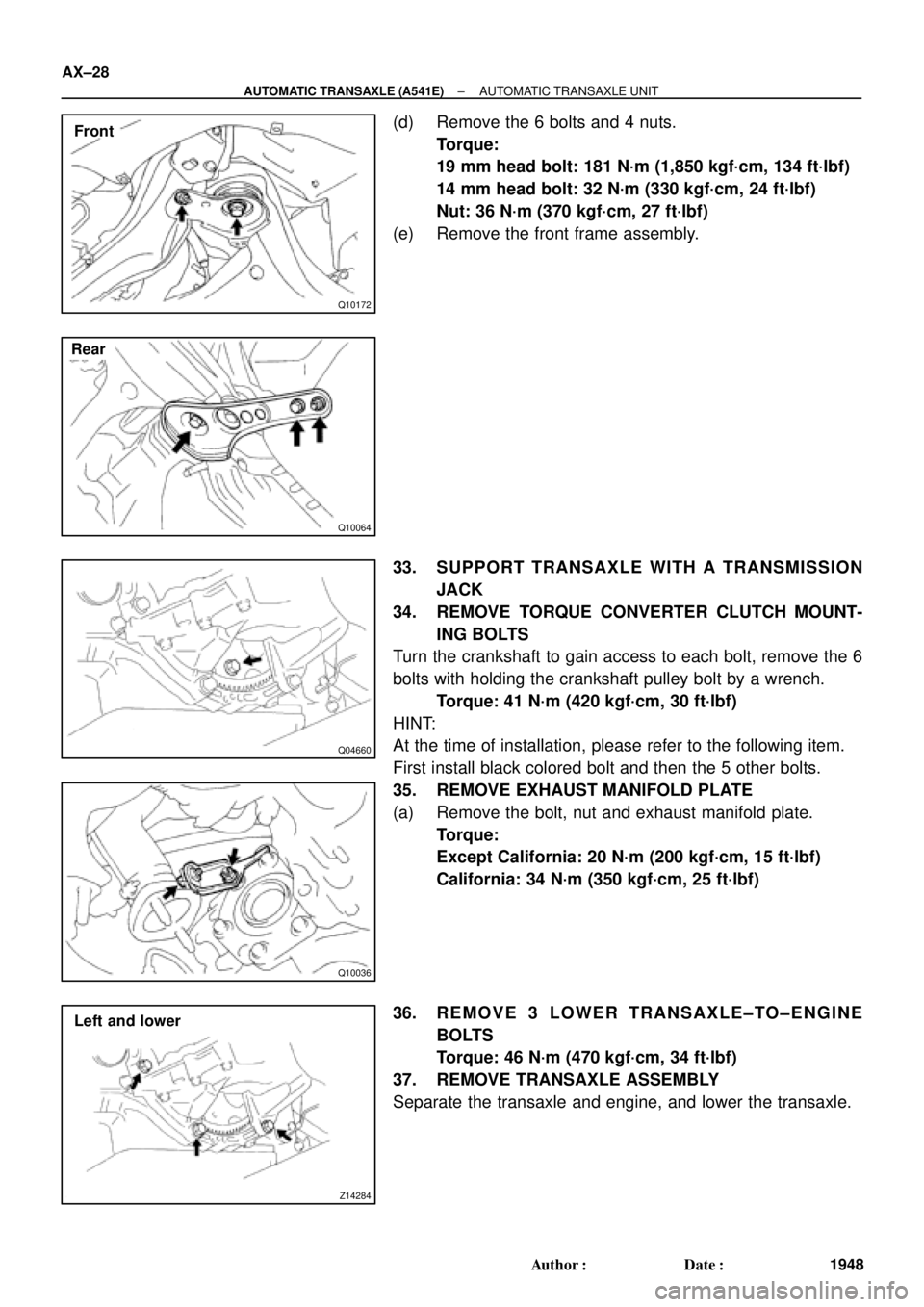Page 1792 of 4770

INTRODUCTIONGLOSSARY OF SAE AND TOYOTA TERMS ±
IN±7
IACIdle Air ControlIdle Speed Control (ISC)
IATIntake Air TemperatureIntake or Inlet Air Temperature
ICMIgnition Control Module±
IFIIndirect Fuel InjectionIndirect Injection
IFSInertia Fuel±Shutoff±
ISCIdle Speed Control±
KSKnock SensorKnock Sensor
MAFMass Air FlowAir Flow Meter
MAPManifold Absolute PressureManifold Pressure
Intake Vacuum
MCMixture Control
Electric Bleed Air Control Valve (EBCV)
Mixture Control Valve (MCV)
Electric Air Control Valve (EACV)
MDPManifold Differential Pressure±
MFIMultiport Fuel InjectionElectronic Fuel Injection (EFI)
MILMalfunction Indicator LampCheck Engine Light
MSTManifold Surface Temperature±
MVZManifold Vacuum Zone±
NVRAMNon±Volatile Random Access Memory±
O2SOxygen SensorOxygen Sensor, O2 Sensor (O2S)
OBDOn±Board DiagnosticOn±Board Diagnostic (OBD)
OCOxidation Catalytic ConverterOxidation Catalyst Converter (OC), CCo
OPOpen LoopOpen Loop
PAIRPulsed Secondary Air InjectionAir Suction (AS)
PCMPowertrain Control Module±
PNPPark/Neutral Position±
PROMProgrammable Read Only Memory±
PSPPower Steering Pressure±
PTOXPeriodic Trap OxidizerDiesel Particulate Filter (DPF)
Diesel Particulate Trap (DPT)
RAMRandom Access MemoryRandom Access Memory (RAM)
RMRelay Module±
ROMRead Only MemoryRead Only Memory (ROM)
RPMEngine SpeedEngine Speed
SCSuperchargerSupercharger
SCBSupercharger Bypass±
SFISequential Multiport Fuel InjectionElectronic Fuel Injection (EFI), Sequential Injection
SPLSmoke Puff Limiter±
SRIService Reminder Indicator±
SRTSystem Readiness Test±
STScan Tool±
TBThrottle BodyThrottle Body
TBIThrottle Body Fuel InjectionSingle Point Injection
Central Fuel Injection (Ci)
TCTurbochargerTurbocharger
TCCTorque Converter ClutchTorque Converter
TCMTransmission Control ModuleTransmission ECU (Electronic Control Unit)
TPThrottle PositionThrottle Position
TRTransmission Range±
Page 1802 of 4770
AUTOMATIC TRANSAXLEPREPARATION ±
AX±6
PREPARATION
SST (SPECIAL SERVICE TOOLS)
09226±10010Crankshaft Front & Rear Bearing
ReplacerInstall RH retainer oil seal
09240±00020Wire Gauge Set
09316±20011Transfer Bearing Replacer
09316±60011Transmission & Transfer Bearing
Replacer
(09316±00011)Replacer Pipe
09350±32014TOYOTA Automatic Transmission
Tool Set
09308±10010Oil Seal Puller
(09351±32032)Counter Driven Gear Holding Tool
(09351±32040)No.1 Piston Spring Compressor
(09351±32050)Snap Ring Expander
(09351±32061)Oil Pump Puller
(09351±32070)No.2 Piston Spring Compressor
(09351±32080)Lock Nut Wrench
AX02L±06
Page 1829 of 4770

AUTOMATIC TRANSAXLECOMPONENT PARTS REMOVAL ±
AX±33
GENERAL NOTES
The instructions here are organized so that you work on only one component group at a time.
This will help avoid confusion from similar±looking parts of different subassemblies being on your work-
bench at the same time.
The component groups are inspected and repaired from the converter housing side.
As much as possible, complete the inspection, repair and assembly before proceeding to the next compo-
nent group. If a component group cannot be assembled because parts are being ordered, be sure to keep
all parts of that group in a separate container while proceeding with disassembly, inspection, repair and
assembly of other component groups.
Recommended fluid for the automatic transaxle: ATF D±@@@@@: [g 2] or DEXRON®@@@@@: [g
3](DEXRON®@@@@@: [g 2])
1. GENERAL CLEANING NOTES:
(a) All disassembled parts should be washed clean and any fluid passages and holes blown through with
compressed air.
(b) When using compressed air to dry parts, always aim away from yourself to prevent accidentally spray-
ing automatic transaxle fluid or kerosene in your face.
(c) The recommended automatic transaxle fluid or kerosene should be used for cleaning.
2. PARTS ARRANGEMENT:
(a) After cleaning, the parts should be arranged in the correct order to allow efficient inspection, repairs,
and reassembly.
(b) When disassembling a valve body, be sure to keep each valve together with the corresponding spring.
(c) New brakes and clutches that are to be used for replacement must be soaked in transaxle fluid for at
least fifteen minutes before assembly.
3. GENERAL ASSEMBLY:
(a) All oil seal rings, clutch discs, clutch plates, rotating parts, and sliding surfaces should be coated with
transmission fluid prior to reassembly.
(b) All gaskets and rubber O±rings should be replaced.
(c) Make sure that the ends of a snap ring are not aligned with one of the cutouts and are installed in the
groove correctly.
(d) If a worn bushing is to be replaced, the subassembly containing that bushing must be replaced.
(e) Check thrust bearings and races for wear or damage. Replace if necessary.
(f) Use petroleum jelly to keep parts in place.
AX02T±07
Page 1904 of 4770
AUTOMATIC TRANSAXLECOMPONENT PARTS INSTALLATION ±
AX±108
14. INSTALL DRIVE PINION CAP
(a) Install a new O±ring to the cap.
(b) Install the drive pinion cap to the transaxle case.
4±SPEED GEAR UNIT INSTALLATION
1. INSTALL PARKING LOCK PAWL
(a) Place the parking lock pawl onto the case.
Hook the spring ends to the case and pawl.
(b) Instal the pin into the hole of the case through the spring
and pawl.
2. INSTALL MANUAL VALVE SHAFT
(a) Coat the oil seal lip with MP grease.
(b) Install the manual valve shaft oil seal to the case.
(c) Assembly a new collar to the manual valve lever.
(d) Install the manual valve shaft to the transmission case
through the manual lever.
(e) Install the parking lock rod.
AX0U2±03
Page 1906 of 4770
AUTOMATIC TRANSAXLECOMPONENT PARTS INSTALLATION ±
AX±110
5. INSTALL FIRST AND REVERSE BRAKE PISTON TO
TRANSMISSION CASE
(a) Coat the new O±rings with ATF.
(b) Install the 2 O±rings on the piston.
(c) Push the piston into the bore of the case, facing the spring
seat upward.
6. INSTALL PISTON RETURN SPRING
(a) Place the return spring and snap ring on the piston.
(b) Place SST, and compress the return spring evenly by
tightening the bolt gradually.
SST 09350±32014 (09351±32040)
(c) Install snap ring. Visually check to make sure it is fully
seated and centered by the 3 lugs on the spring retainer.
Be sure the end gap of snap ring is not aligned with the
spring retainer claw.
(d) Remove the SST.
7. INSTALL SNAP RING TO TRANSAXLE CASE
Page 1915 of 4770

AUTOMATIC TRANSAXLECOMPONENT PARTS INSTALLATION ±
AX±119
(b) Place the oil pump through the input shaft, and align the
bolt holes of the pump body with the transmission case.
NOTICE: Do not push on the oil pump strongly or the oil
seal ring will stick to the direct clutch drum.
Torque: 22 N´m (225 kgf´cm, 16 ft´lbf)
26. MEASURE END PLAY OF INPUT SHAFT
Measure the end play with a dial gauge.
End play:
0.25±0.90 mm (0.0098±0.0354 in.)
HINT: There are 2 different thickness bearings for end of
stator shaft. If the end play is in excess of standard, select
one of them.
Bearing thickness:
3.60 mm (0.1417 in.)
4.19 mm (0.1650 in.)
27. CHECK INPUT SHAFT ROTATION
Make sure that the input shaft rotates smoothly.
28. INSTALL SECOND COAST BRAKE PISTON
(a) Coat the new O±rings with ATF and install it to the cover.
(b) Install the outer spring with the piston.
(c) Place the cover into the bore.
(d) Using SST, install the snap ring while pressing the cover.
SST 09350±32014 (09351±32050)
(e) Check that the front end of the piston rod contacts the
center of the second brake band depression.
29. CHECK SECOND COAST BRAKE PISTON STROKE
(a) Apply a small amount of paint to the piston rod at the point
it meets the case.
Page 1956 of 4770

Q10172
Front
Q10064
Rear
Q04660
Q10036
Z14284
Left and lower AX±28
± AUTOMATIC TRANSAXLE (A541E)AUTOMATIC TRANSAXLE UNIT
1948 Author�: Date�:
(d) Remove the 6 bolts and 4 nuts.
Torque:
19 mm head bolt: 181 N´m (1,850 kgf´cm, 134 ft´lbf)
14 mm head bolt: 32 N´m (330 kgf´cm, 24 ft´lbf)
Nut: 36 N´m (370 kgf´cm, 27 ft´lbf)
(e) Remove the front frame assembly.
33. SUPPORT TRANSAXLE WITH A TRANSMISSION
JACK
34. REMOVE TORQUE CONVERTER CLUTCH MOUNT-
ING BOLTS
Turn the crankshaft to gain access to each bolt, remove the 6
bolts with holding the crankshaft pulley bolt by a wrench.
Torque: 41 N´m (420 kgf´cm, 30 ft´lbf)
HINT:
At the time of installation, please refer to the following item.
First install black colored bolt and then the 5 other bolts.
35. REMOVE EXHAUST MANIFOLD PLATE
(a) Remove the bolt, nut and exhaust manifold plate.
Torque:
Except California: 20 N´m (200 kgf´cm, 15 ft´lbf)
California: 34 N´m (350 kgf´cm, 25 ft´lbf)
36. REMOVE 3 LOWER TRANSAXLE±TO±ENGINE
BOLTS
Torque: 46 N´m (470 kgf´cm, 34 ft´lbf)
37. REMOVE TRANSAXLE ASSEMBLY
Separate the transaxle and engine, and lower the transaxle.
Page 2425 of 4770

N09214
S05347
± DIAGNOSTICSENGINE (5S±FE)
DI±5
240 Author�: Date�:
(b) Check the DLC3
The vehicle's ECM uses ISO 9141±2 for communication.
The terminal arrangement of DLC3 complies with SAE
J1962 and matches the ISO 9141±2 format.
Terminal No.Connection / Voltage or ResistanceCondition
7Bus � Line / Pulse generationDuring transmission
4Chassis Ground e Body Ground /1 W or lessAlways
5Signal Ground e Body Ground /1 W or lessAlways
16Battery Positive e Body Ground /9 ~ 14 VAlways
HINT:
If your display shows ºUNABLE TO CONNECT TO VEHICLEº
when you have connected the cable of the OBD II scan tool or
TOYOTA hand±held tester to DLC3, turned the ignition switch
ON and operated the scan tool, there is a problem on the ve-
hicle side or tool side.
�If communication is normal when the tool is connected to
another vehicle, inspect DLC3 on the original vehicle.
�If communication is still not possible when the tool is con-
nected to another vehicle, the problem is probably in the
tool itself, so consult the Service Department listed in the
tool's instruction manual.
2. INSPECT DIAGNOSIS (Normal Mode)
(a) Check the MIL.
(1) The MIL comes on when the ignition switch is turned
ON and the engine is not running.
HINT:
If the MIL does not light up, troubleshoot the combination meter
(See page BE±2).
(2) When the engine started, the MIL should go off. If
the lamp remains on, the diagnosis system has de-
tected a malfunction or abnormality in the system.
(b) Check the DTC.
NOTICE:
TOYOTA hand±held tester only: When the diagnosis sys-
tem is switched from normal mode to check mode, it
erases all DTCs and freezed frame data recorded in normal
mode. So before switching modes, always check the DTCs
and freezed frame data, and note them down.
(1) Prepare the OBD II scan tool (complying with SAE
J1978) or TOYOTA hand±held tester.